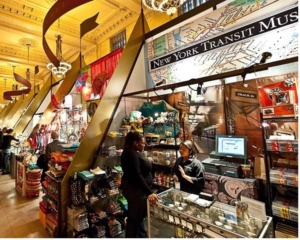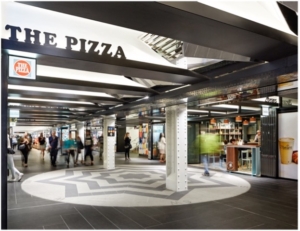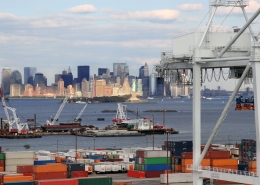Last week, Eno Transportation Weekly identified seven effective strategies to improve retail spaces in train and bus stations. It is a topic important to anyone interested in improving transit amenities, attracting more transit riders, improving safety in stations, and increasing transit agency revenues.
These seven strategies were:
- think about merchandising before creating a space
- develop a retail plan
- contact potential tenants early on
- consider attracting non-riders
- choose tenants who best serve riders
- keep rents affordable
- create turnkey spaces
To learn more about this topic, you can read last week’s article and watch a June 27 webinar, hosted by Eno and the American Planning Association’s Transportation Planning Division, featuring Susan Fine (principal of Fine Development Partners), Charles Di Maggio (CEO of Greystone Management Solutions), and Laura Barr (senior vice president for consumer and retail at CBRE).
Here are eight more equally effective strategies to improve retail spaces in train and bus stations.
#8. Think of Retail as Event Space
When you think of the retail environment as an event space, you can come up with an endless number of ways to create a “fun” environment so that stations feel safer and more vibrant. Interactive displays can be set up, products demonstrated, workshops held, and local artists can display their wares. Susan Fine’s firm has asked young women to sell Girl Scout cookies at a transit station, and Charles Di Maggio runs the musical performers program on behalf of Boston’s subway system. When done well, musical programs can entertain passengers and create a positive and vibrant atmosphere for retailers.

Photo: Grand Central Terminal Christmas Market (Credit: Jazz Guy from New Jersey, Wikimedia Commons)
#9. Partner with Communities
Transit agencies should partner with local institutions and consider creating space for them in transit stations. Libraries and cultural organizations can drive foot traffic, bring in new transit riders and retail customers, create livelier spaces, and enhance an agency’s reputation with the communities they serve.
Susan Fine’s firm, which developed and now manages retail space in New York City’s Columbus Circle subway station, provides free retail space to an organization that promotes Broadway shows. She does so because it encourages people to slow down and shop. She said, “If 80 percent of your stores are revenue producing, there’s no reason in the world why you want the other 20 percent to sit empty because it hurts everybody. So, why not give them to a local art school. It doesn’t cost you anything, as long as they can pay for their electricity and keep the lights on.”
Fine said bringing in local groups whether they are museums or animal adoption centers, shows the community that the agency cares. “If you give a space to a beloved not-for-profit in the community,” she says, “you’re signaling that we are more than a transit agency, we are a part of this community.”
Di Maggio’s firm — as the designated real estate representative for transit agencies in Massachusetts, Pennsylvania, and New York — manages dozens of transit retail locations. He warns of the challenges associated with administering certain labor-intensive programs, such as hosting a Sunday farmers market in an otherwise empty station parking lot. These programs often take more resources than expected because the parking area has to be kept clean and insurance acquired. Moreover, the market needs ongoing publicity, farmers and local businesses must be recruited, and constant oversight is needed to ensure that vendors are attending regularly and offering a wide variety of products.
#10. Attract Local Retailers
All the panelists emphasized the importance of bringing in local businesses and not relying on national chains. Small businesses can provide customers with a wider variety of options, promote diversity, and cater to the specific tastes and preferences of a community. This creates a more exciting and engaging shopping experience, and of course also helps local residents and contributes to the surrounding community.
Fine talked about transit riders who line up at the eateries that she personally recruited – including small businesses making and selling Venezuelan empanadas, Bolivian Salteñas, and Taiwanese dumplings.
#11. Develop and Nurture a Relationship with Retailers
Just as agencies should think of transit riders as customers rather than users, they should also think of retailers as partners rather than tenants. Transit agencies need to understand retailers’ needs, because when they succeed, so too does the agency and its customers.
A landlord-tenant adversarial relationship can lead to all sorts of problems for both the agency and the retailer. Transit agencies should not surprise retailers with unexpected expenses or forget to notify them when transit services need to be shut down for safety reasons, construction, or inclement weather.
Agencies should help tenants understand both the challenges and opportunities, early on. This is especially the case for small business owners who will need more handholding as they fit out their space, obtain appropriate permits, and begin to sell their products. Laura Barr, who works with a wide range of commercial developers and retailers, said that engaging in productive conversations can help create some of the best and most vibrant retail spaces.
#12. Set up a Public Private Partnership
When a public agency needs to approve individual tenants, the process can often be cumbersome and lengthy. Agencies that enter into a public private partnership to manage their retail space can usually be more creative, sign leases faster, and offer more flexible terms. Also, private partners can often take risks that public agencies cannot. Susan Fine’s Turnstyle project in the New York subway station was lauded by the other panelists and praised by the New York Times as “bright”, “cheery”, and a “home for underground gourmets.”


Before and after photos of Turnstyle shopping space (Credit: Turnstyle)
#13. Start With Pop-ups
On Eno’s recent webinar about transit retail, a representative from a midwestern transit agency asked the panelists for suggestions on how to bring back retailers that they lost after COVID. Susan Fine suggested creating pop-up stores because temporary retail spaces can help vendors test the market and sell seasonal items. For example, the same vendors who typically rely on Etsy and other online channels to sell their wares, can set up shop in transit stations before Halloween, Thanksgiving, and Christmas. The transit agencies and businesses would need to promote these shops through the local media and institutions.
#14. Create the Right Size Tenant Spaces
Transit agencies need to be thoughtful about the size of retail spaces they create. Although an agency might prefer renting out one large space, retailers often prefer smaller spaces because they can be more profitable. Having two small successful retail shops is certainly better than having one large struggling business.
#15. Reconceive Transit Retail as an Amenity
The most important lesson that Susan Fine wanted to share with transit agencies was that they need to reconceive transit retail as an amenity rather than a way to maximize revenues.
Better retail can help bring customers back, bring in more revenue, and liven otherwise dead spaces.
People are more likely to use transit if they see stores open and customers in shops. Barr noted “without a question having more eyes in general” helps with the perception of safety and encourages people to use transit and shop at its stores.
















